It’s time to leave the Netherlands and set off for adventures in other lands!
Highlights – the overview
It’s Sunday July 28th, we have beautiful weather, and we set off for our 3-day passage… destination Cherbourg, France! We sail all day and through the night, doing 3-hour shifts called “watches”.
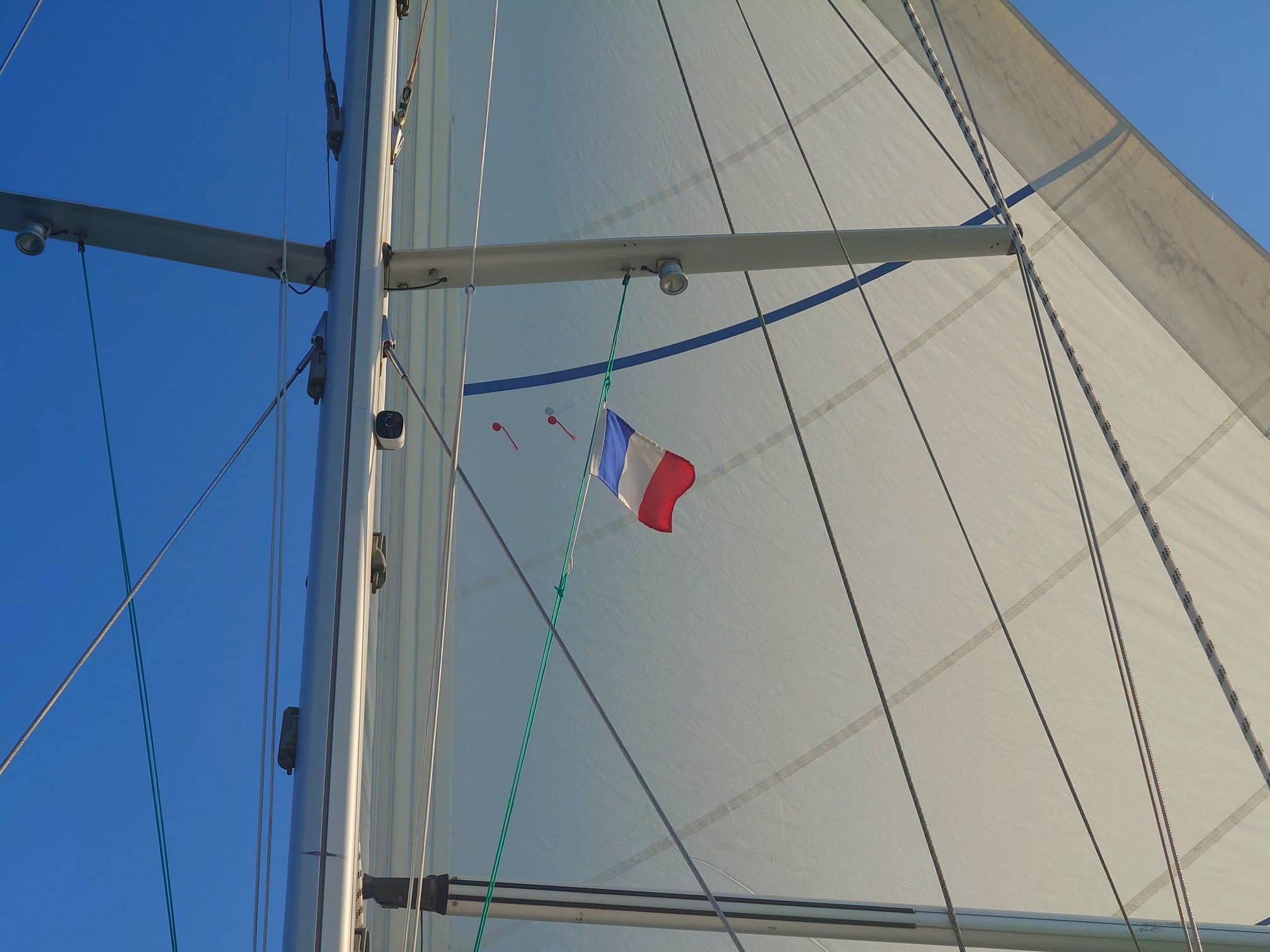
And then we are in France! So, we hoist the French courtesy flag. Whenever you sail in another (not your home) country’s waters, you place a small flag from the “spreaders” on the right side off your main mast as a courtesy to the country you are visiting.
In the afternoon, we pass Dunkerque and Calais. Here, there’s very busy shipping traffic. Ferry’s to and from Britain cross our path. At Calais, we have to avoid 5 big ferry vessels. Luckily, some of them avoid us! During this short crossing between Dunkerque and Cap Griz Nez we see about 20 ferry’s!
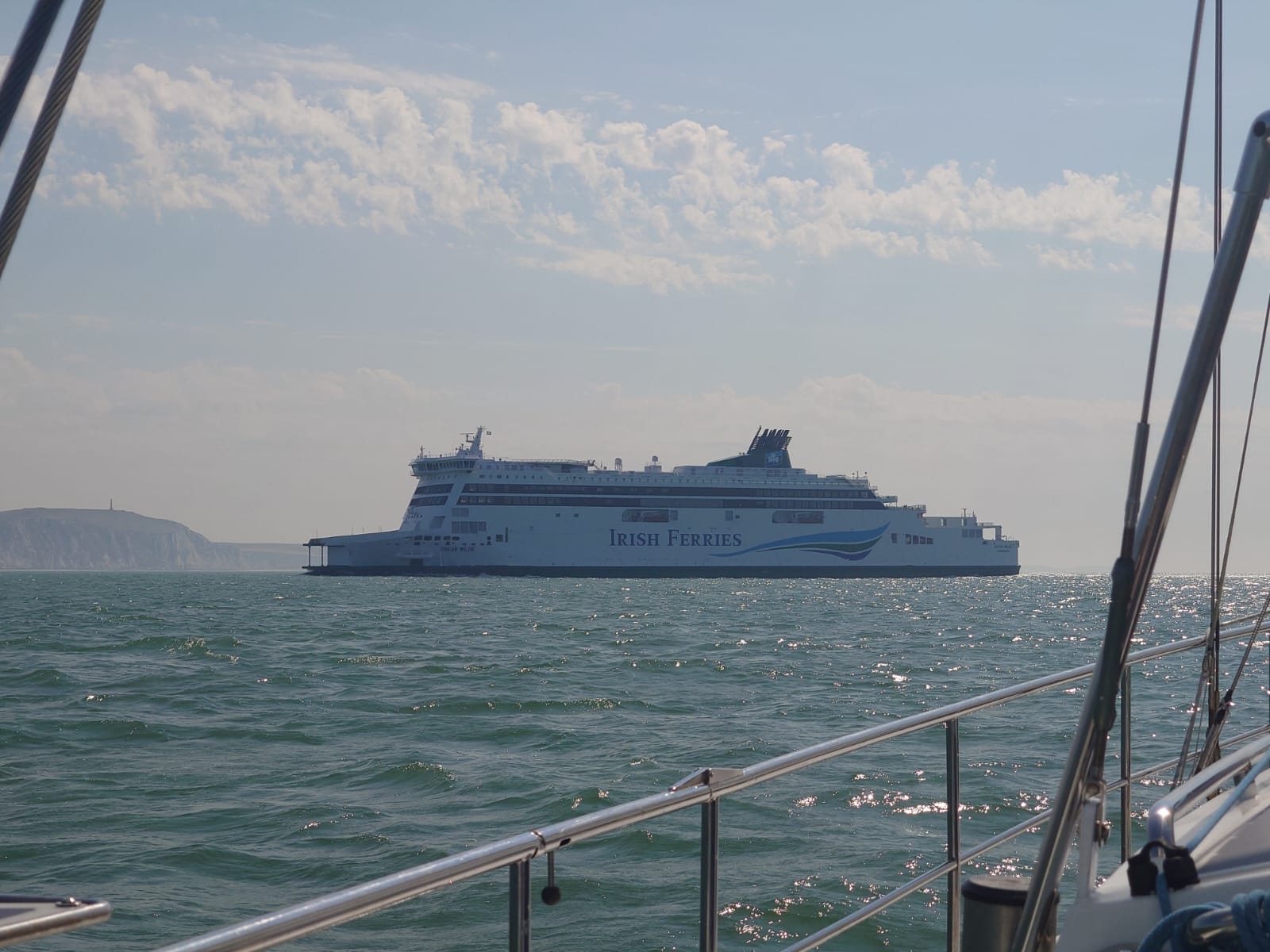
We have beautiful sunrises and sunsets, and enjoy the passage very much. At night, we rely on our instruments and also visual checks to make sure we are clear of any other boats that may not be transmitting their positions. Below is an overview of our night-time experience, and in the Captain’s Log there’s much more information and photos!
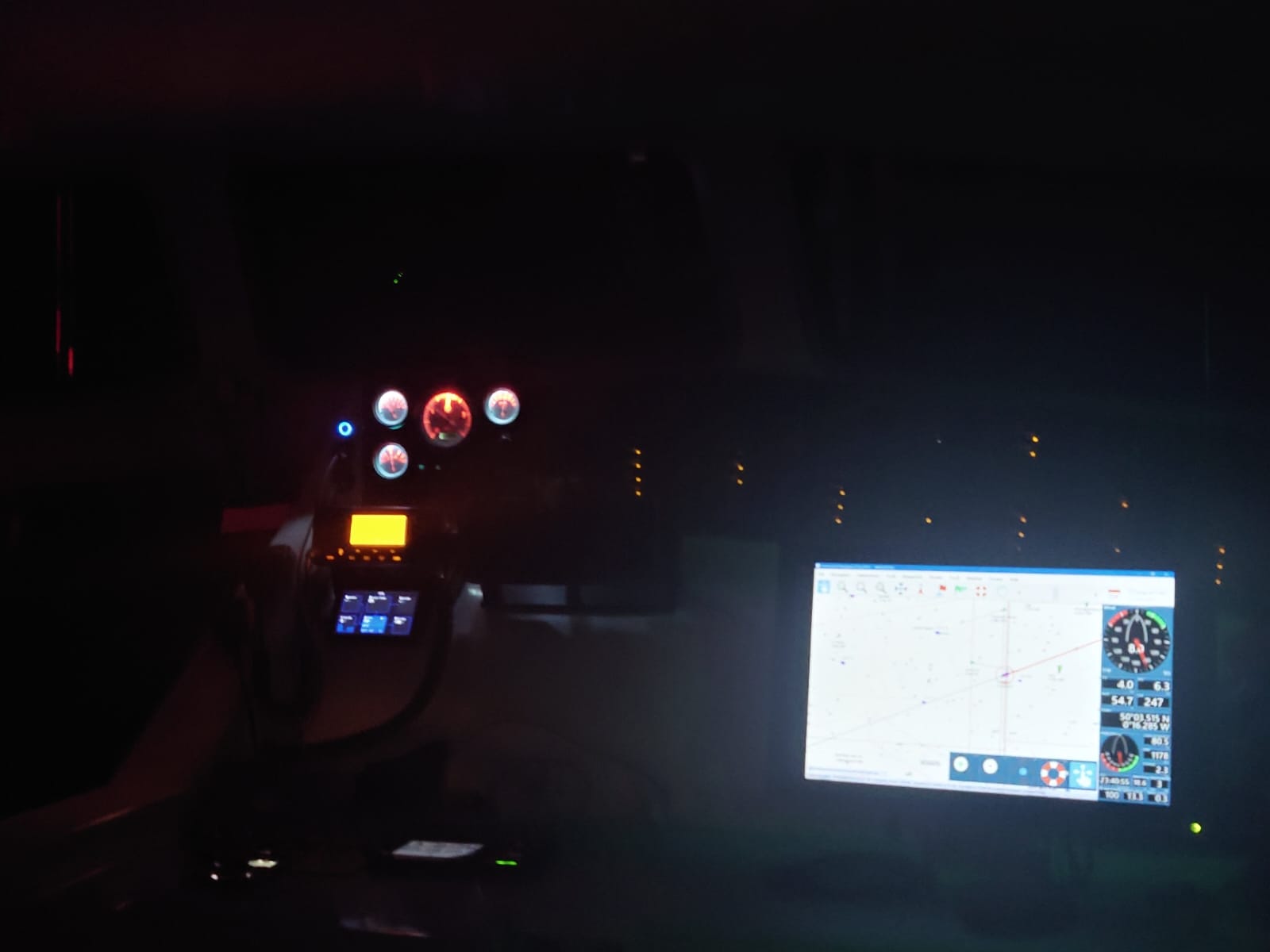
During our 3-hour watch, we sit in the deck salon. Here, we sit comfy and we can look around through the large windows all around (front, side and back in our deck salon) while monitoring the equipment and listening to the VHF radio. Every 10 minutes we have a look outside because outside, in complete darkness, we have a better view of the lights around us. And of course, we can admire the beauty around us: the stars, the moon and sometimes bioluminescence – the sparkling bits like stars in the sea!
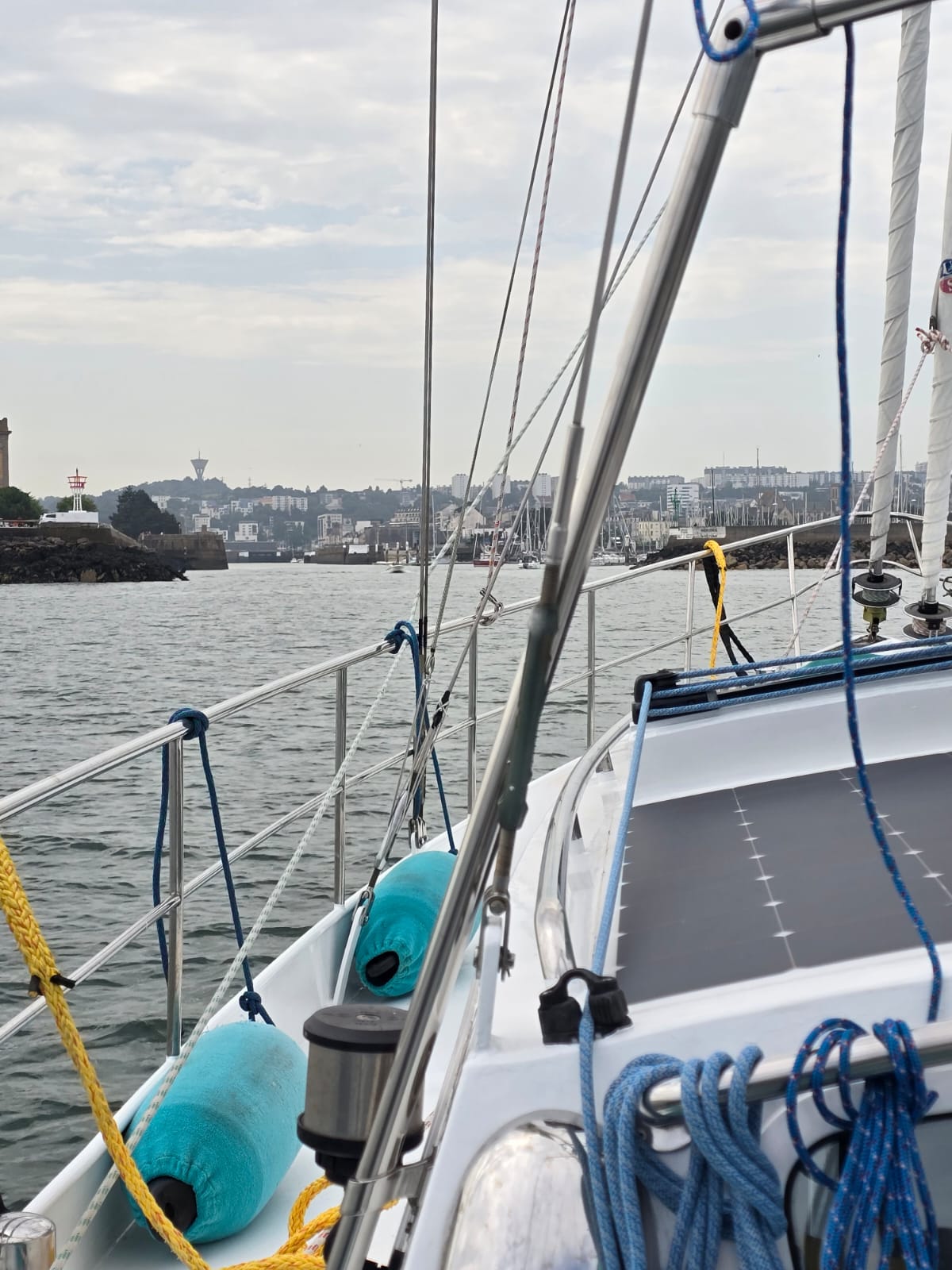
During the last night, there are thunder storms over the land, which give us quite a light show. Luckily, with the cooler temperatures at sea, we sail on with clear skies. For a while, the seas pick up and Dione IV is rocking and rolling, but taking the waves in stride. We feel very confident in the boat and each other, so we are not worried.
The next morning, the conditions are calmer and we sail the last 50 miles with comfortable winds and seas.
A little past noon, we enter the port of Cherbourg. Arrived!
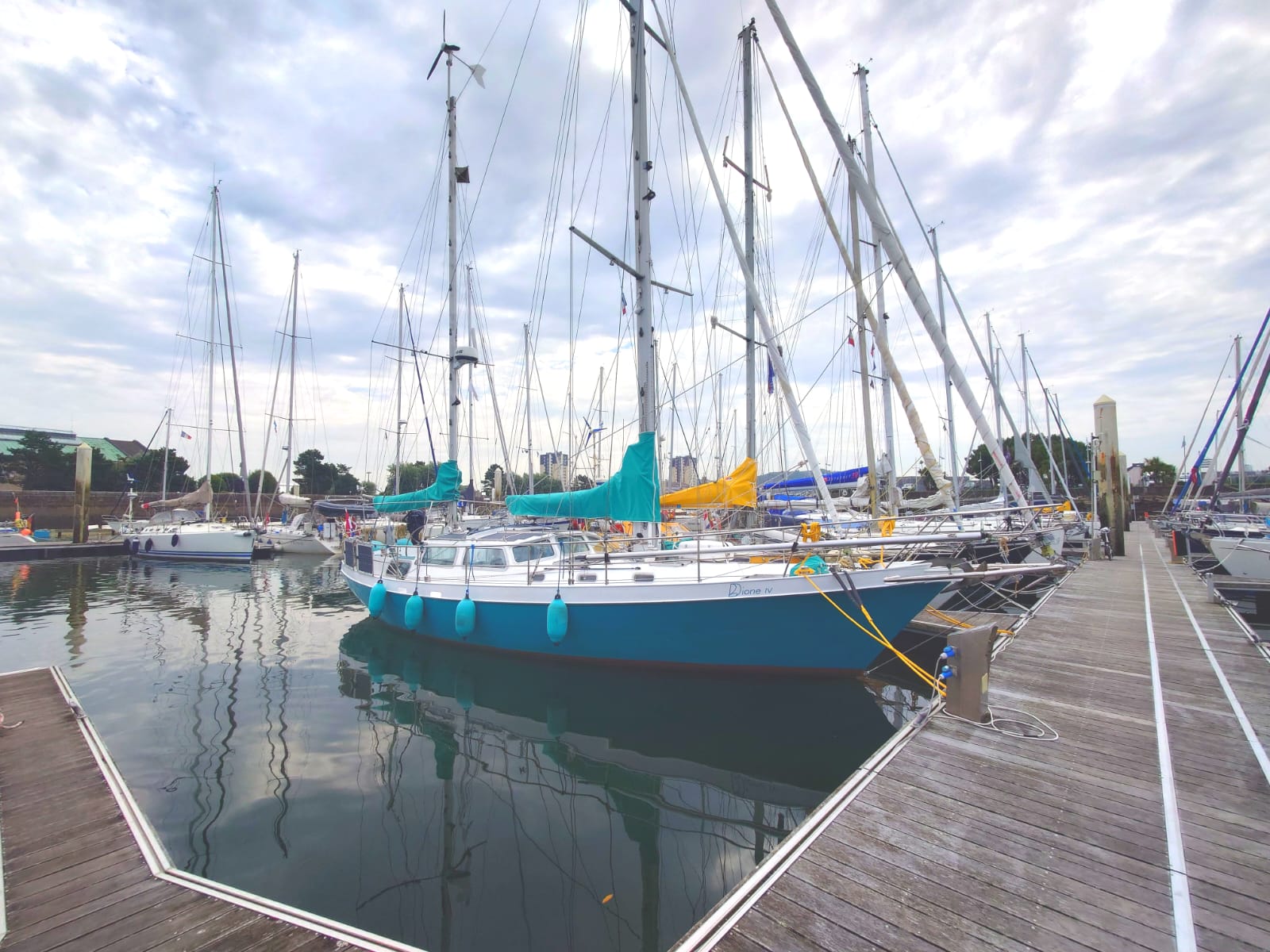
By 1 o’clock we tie up in the marina of Cherbourg, have lunch, and then clean the salt off the decks.
Our trip was 280 nautical miles (about 500km) in 3 days and 3 nights. That’s not a fast passage, but we aren’t in a hurry and it has been a great trip.
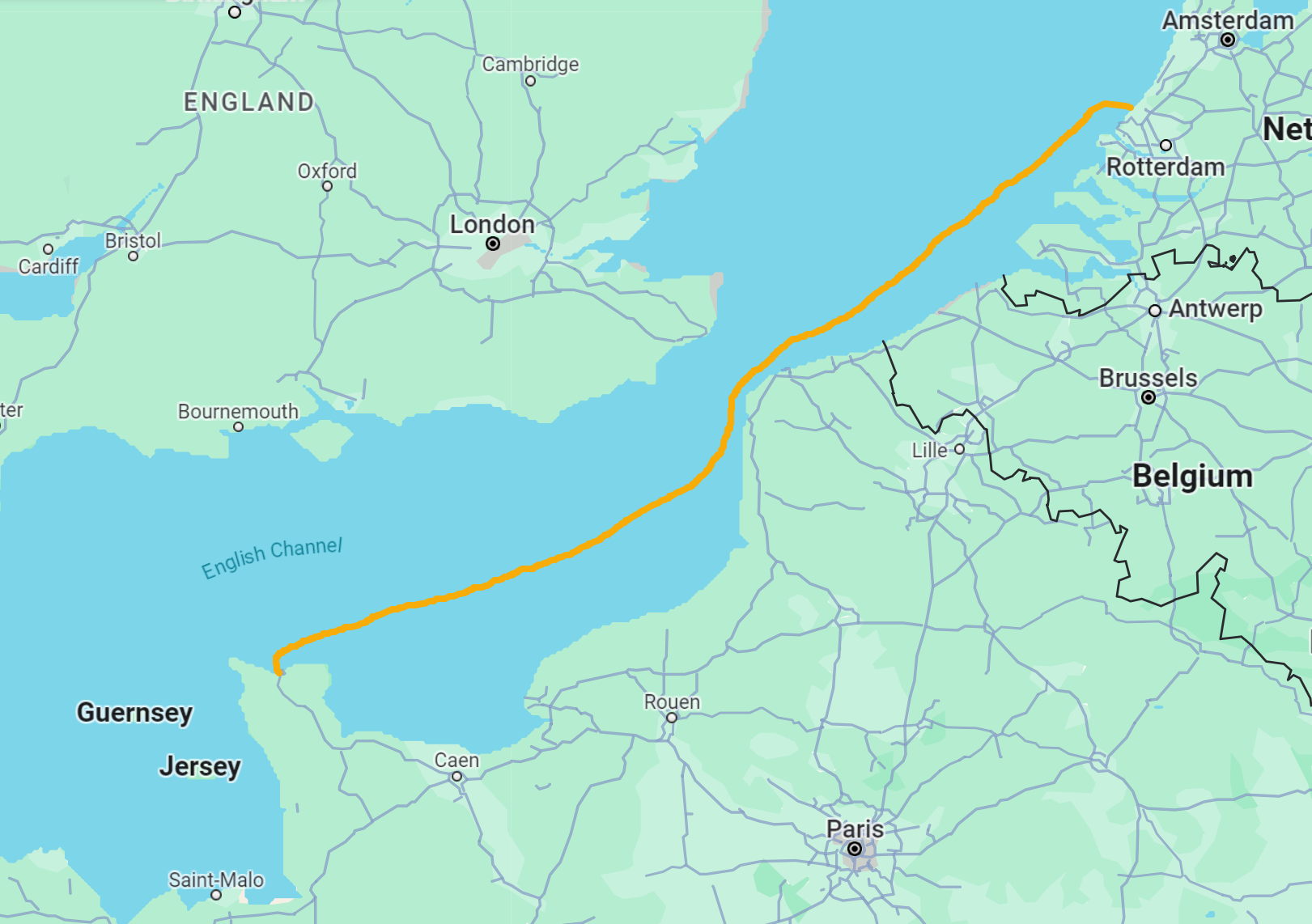
We did really well on our first passage together! We’re not too tired because we slept reasonably well with our 3-hour shifts. We have full confidence in each other’s sailing capabilities, so when one of us has the watch, the other can sleep peacefully. We had delicious meals and gorgeous views. We saw porpoises (but no dolphins, but they are just as good luck) and gannets, and we just enjoyed being together at sea! In fact, we feel a bit sad that we are tied up in this extremely busy and noisy marina and we decide to get out of here as soon as possible, after provisioning!… tomorrow 🙂
Captain’s Log (T+28-31) – the complete story
July 28 – Leaving the Netherlands
After breakfast, we depart from the marina of Scheveningen in The Hague. It’s sunny, 23°C and there’s a light breeze from the NW.
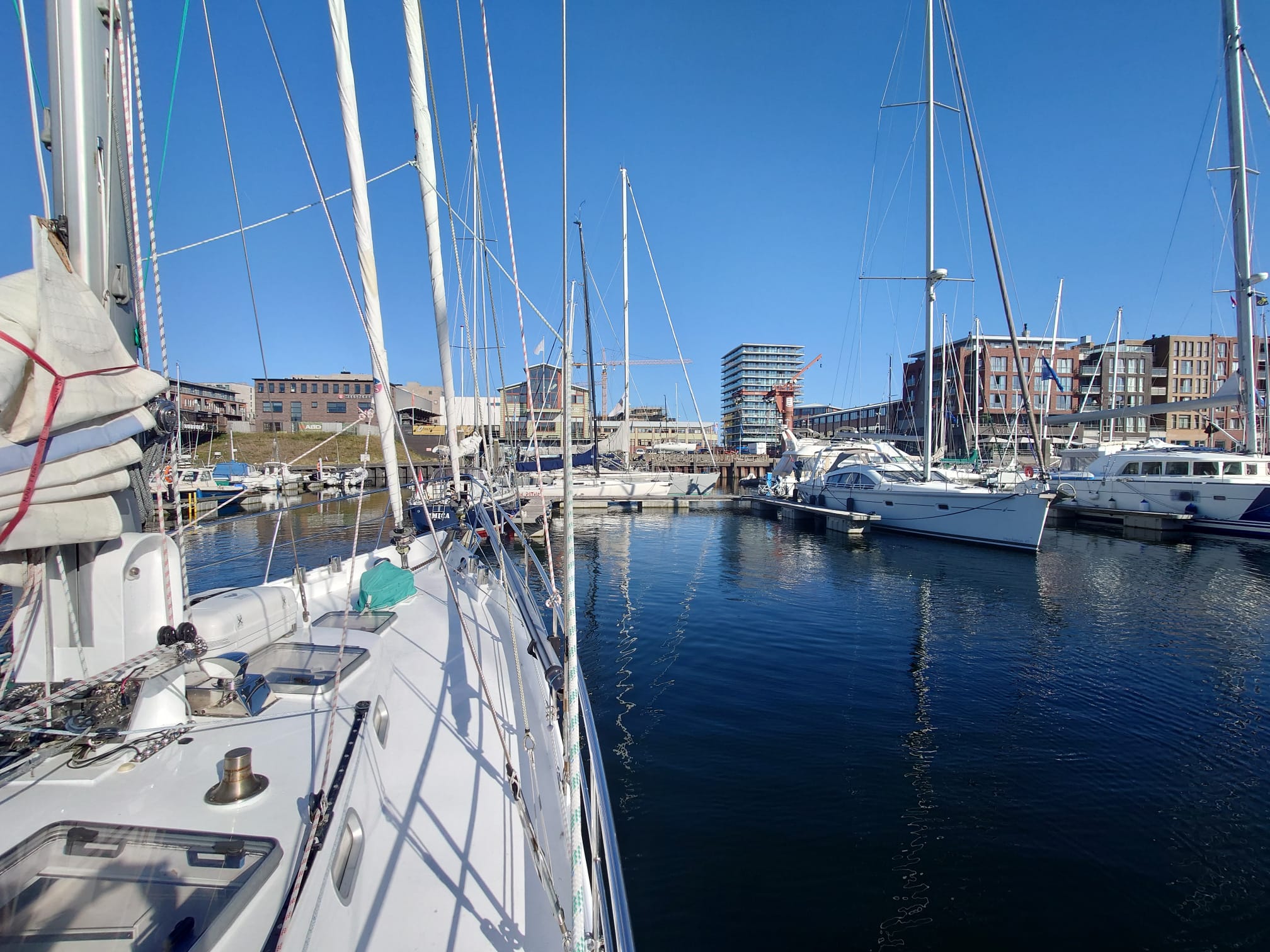
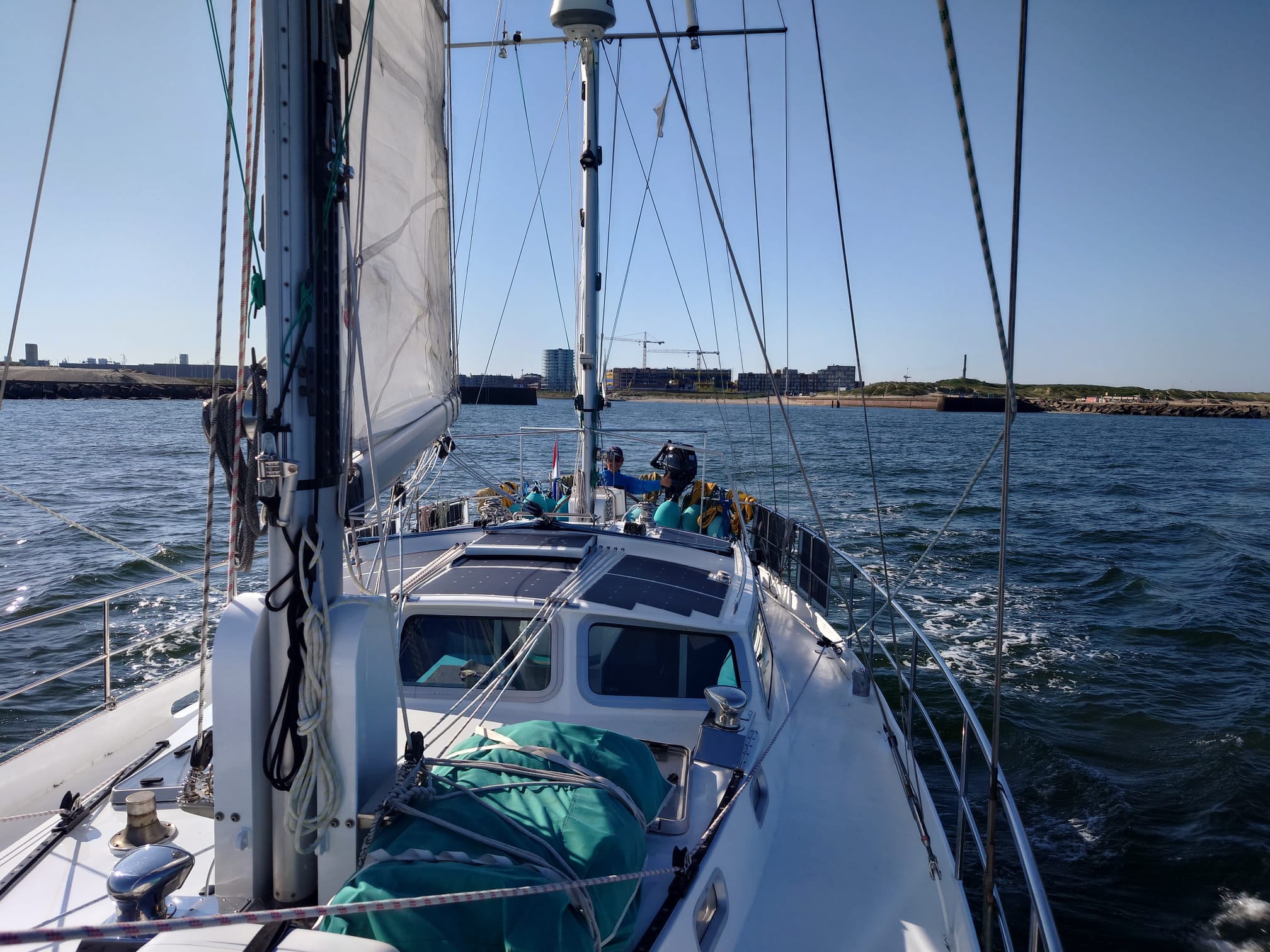
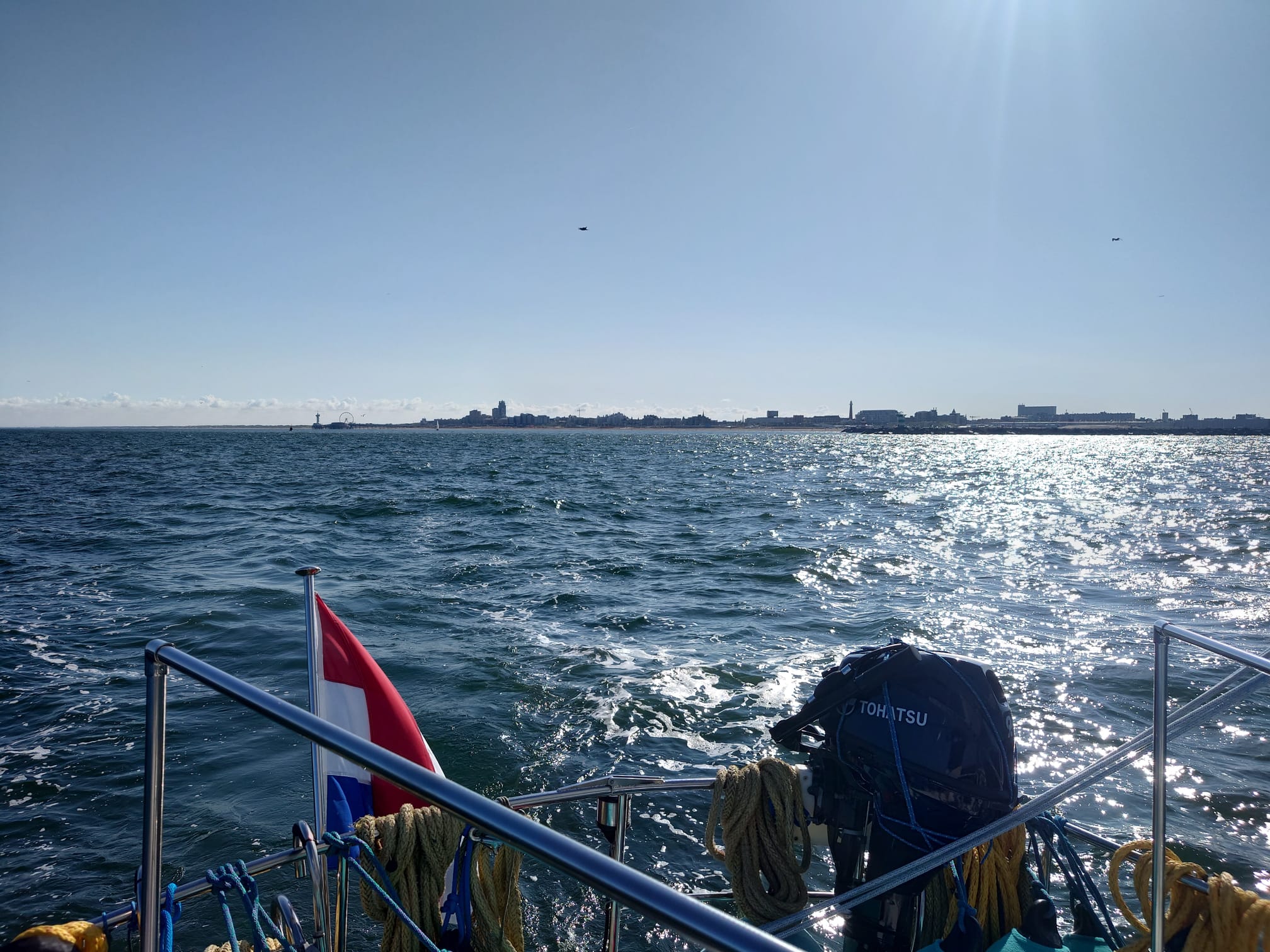
It’s a lovely sailing day. At sunset, we are at the latitude of “Vlissingen” (or London, for those not familiar with Vlissingen).
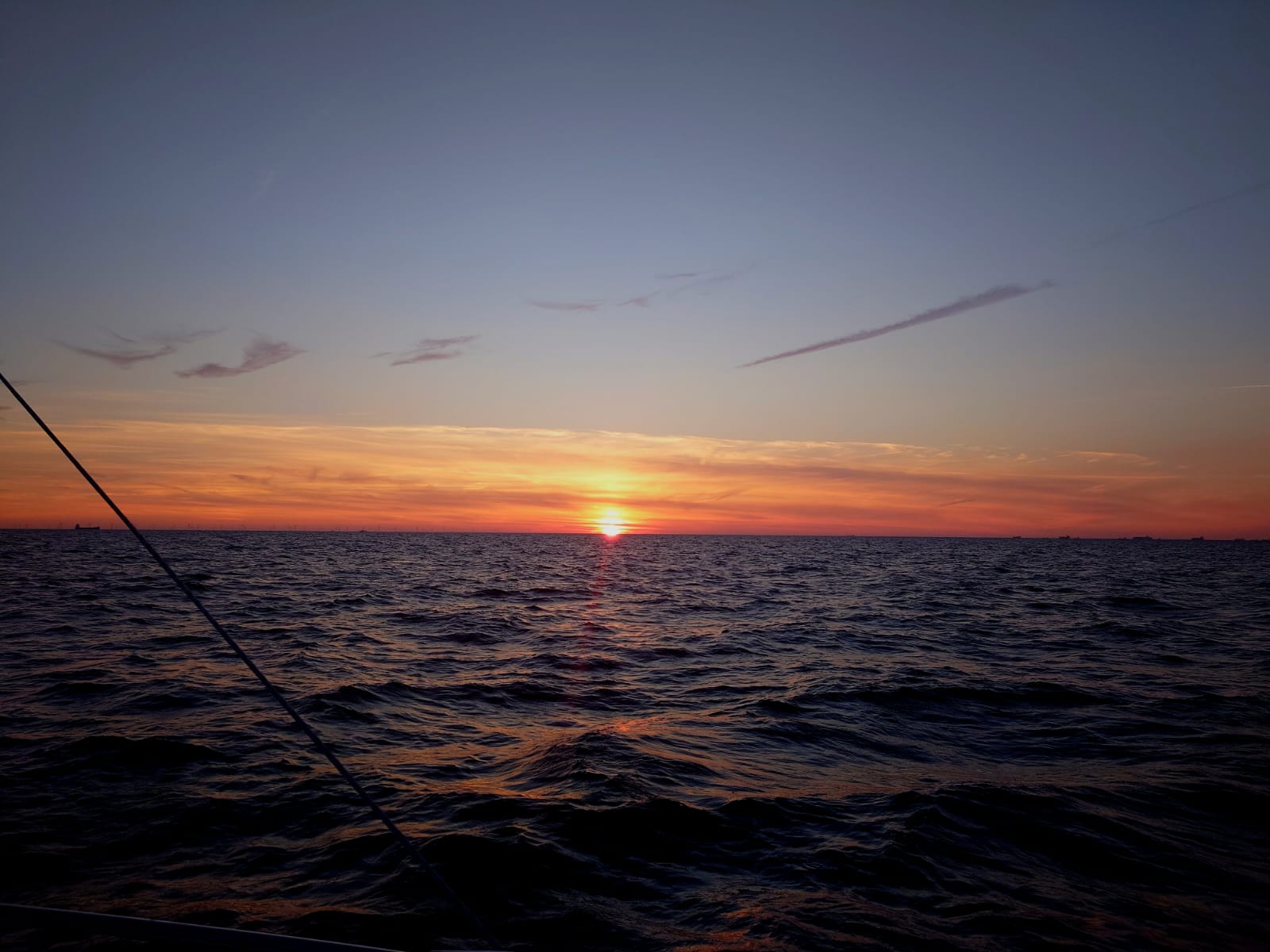
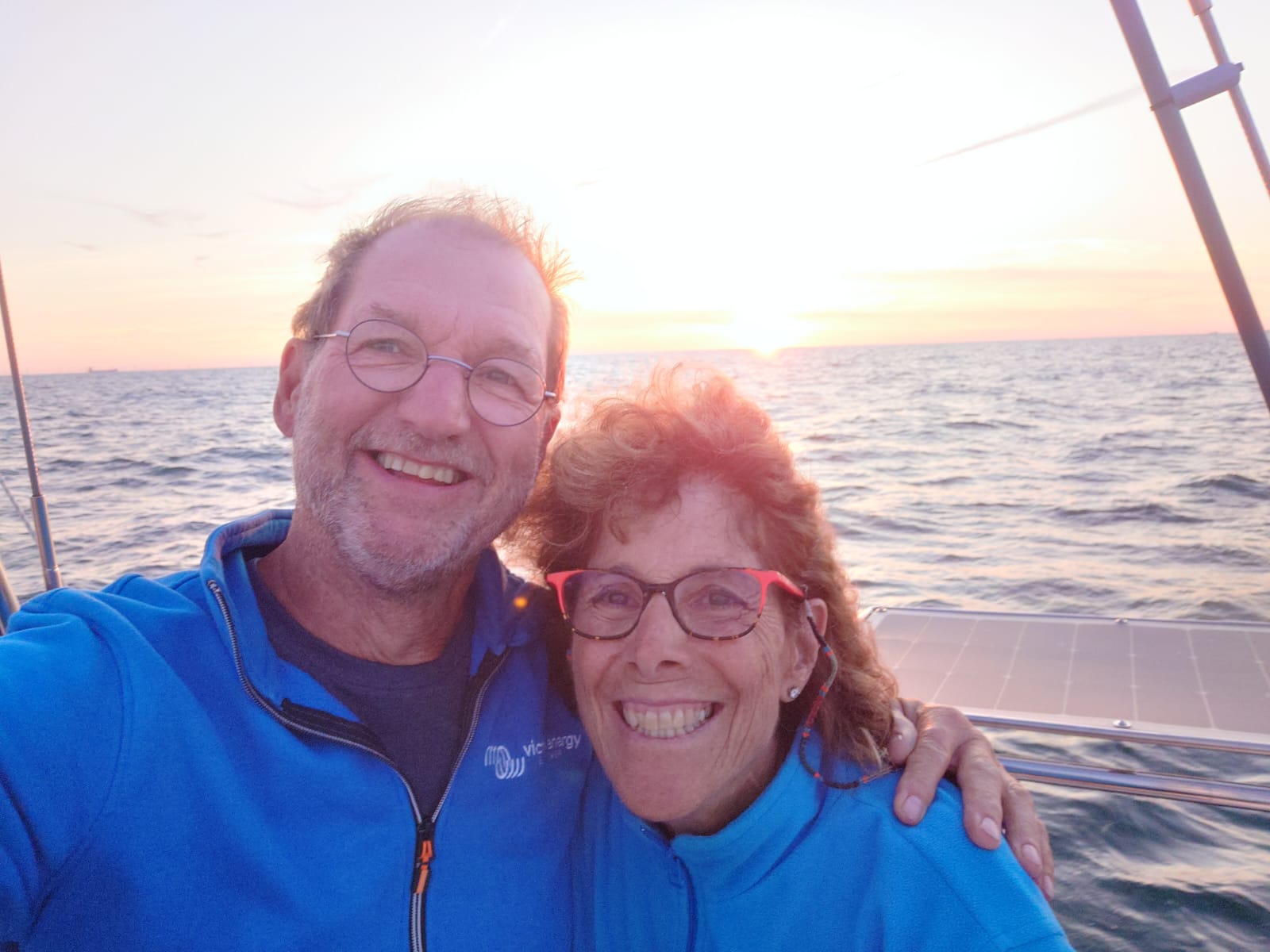

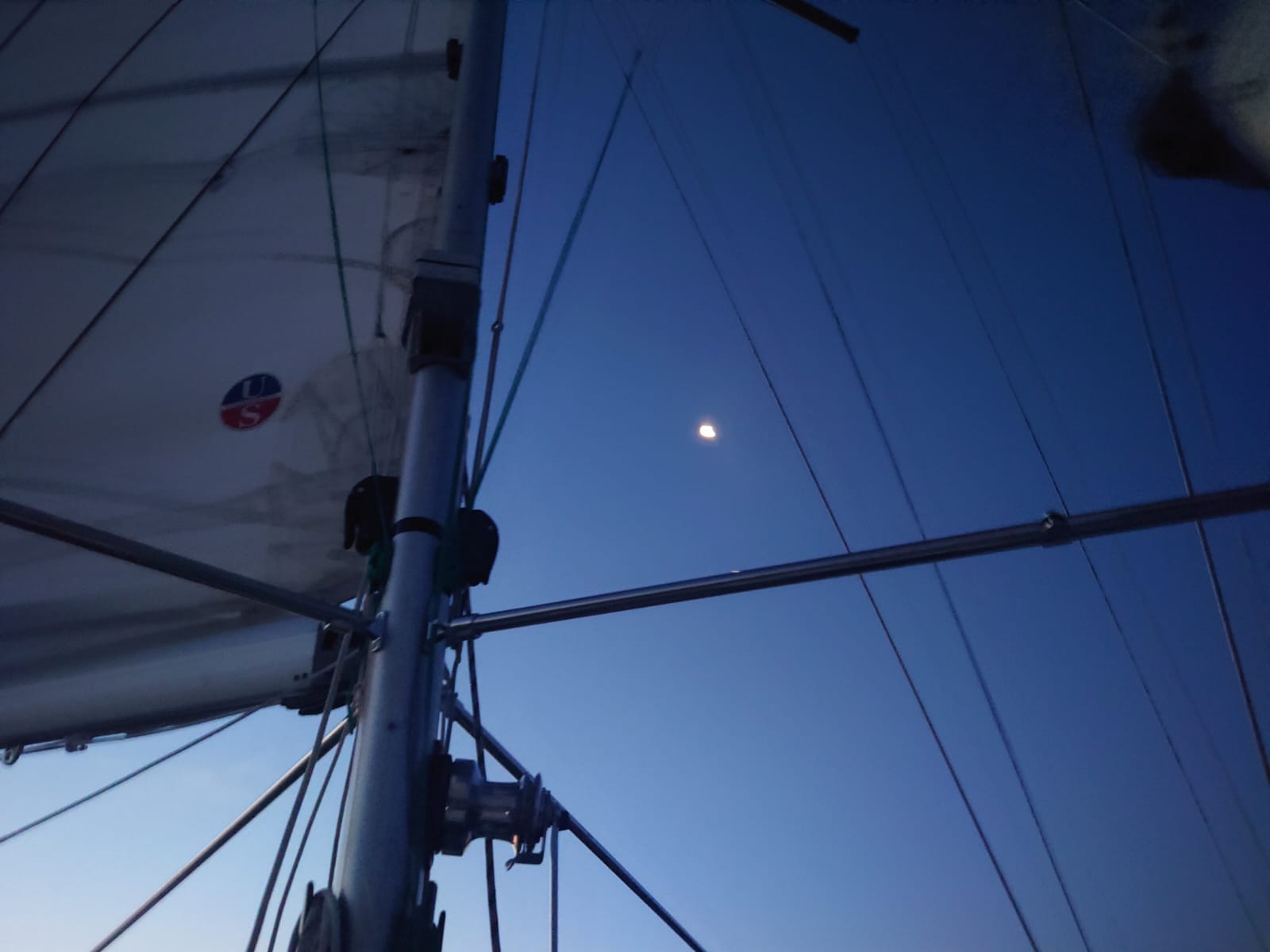
We sail through the night and do 3-hour shifts. There’s a light North-East breeze so we can keep sailing.
There’s a half moon that lights up the night.
July 29 – passing the Belgian coast and into France!
In the afternoon, we pass Dunkerque and Calais. Here, there’s very busy shipping traffic. Ferry’s to and from Britain cross our path. At Calais, we have to avoid 5 big ferry vessels. Luckily, some of them avoid us! During this short crossing between Dunkerque and Cap Griz Nez we see about 20 ferry’s!
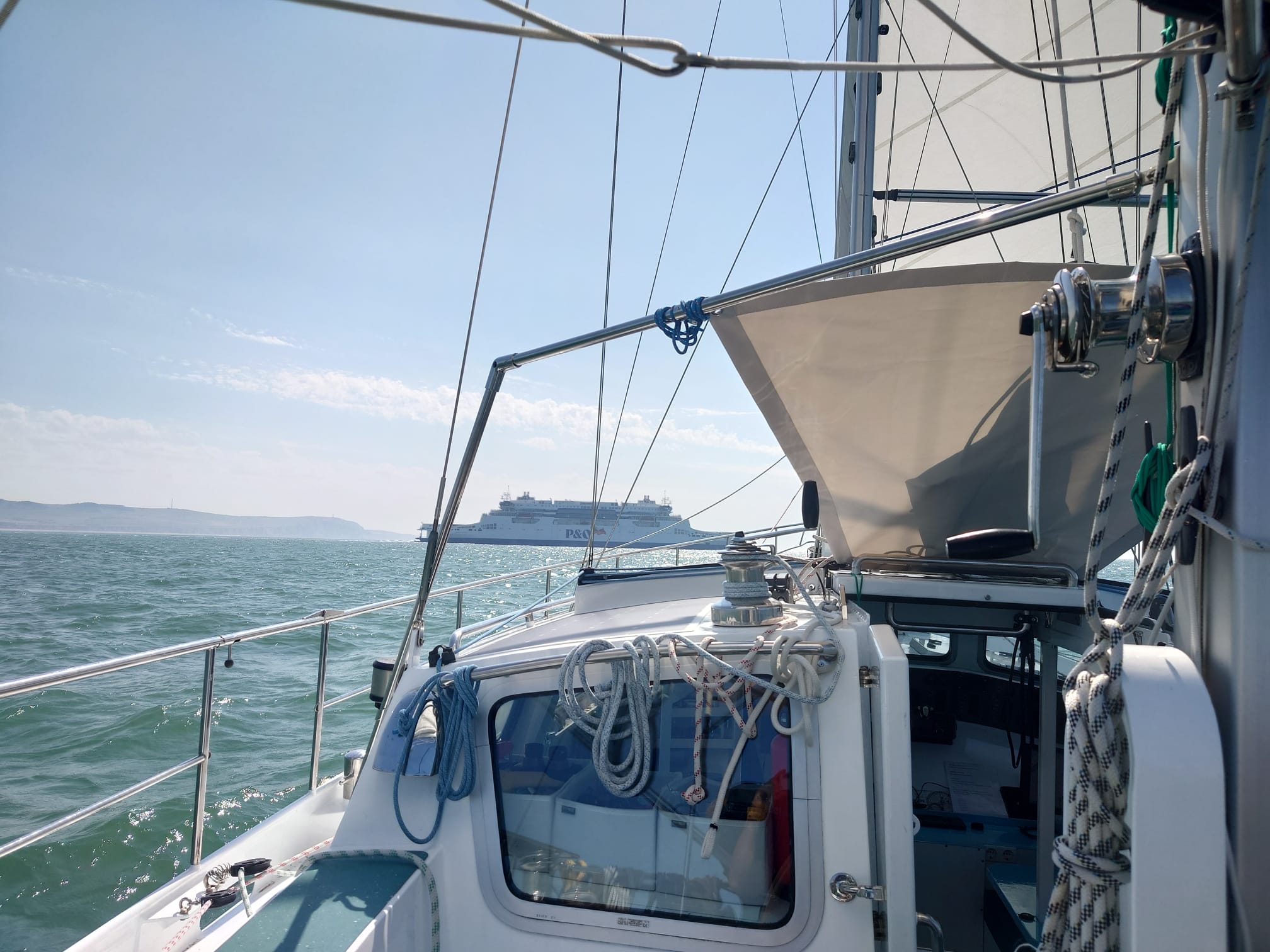


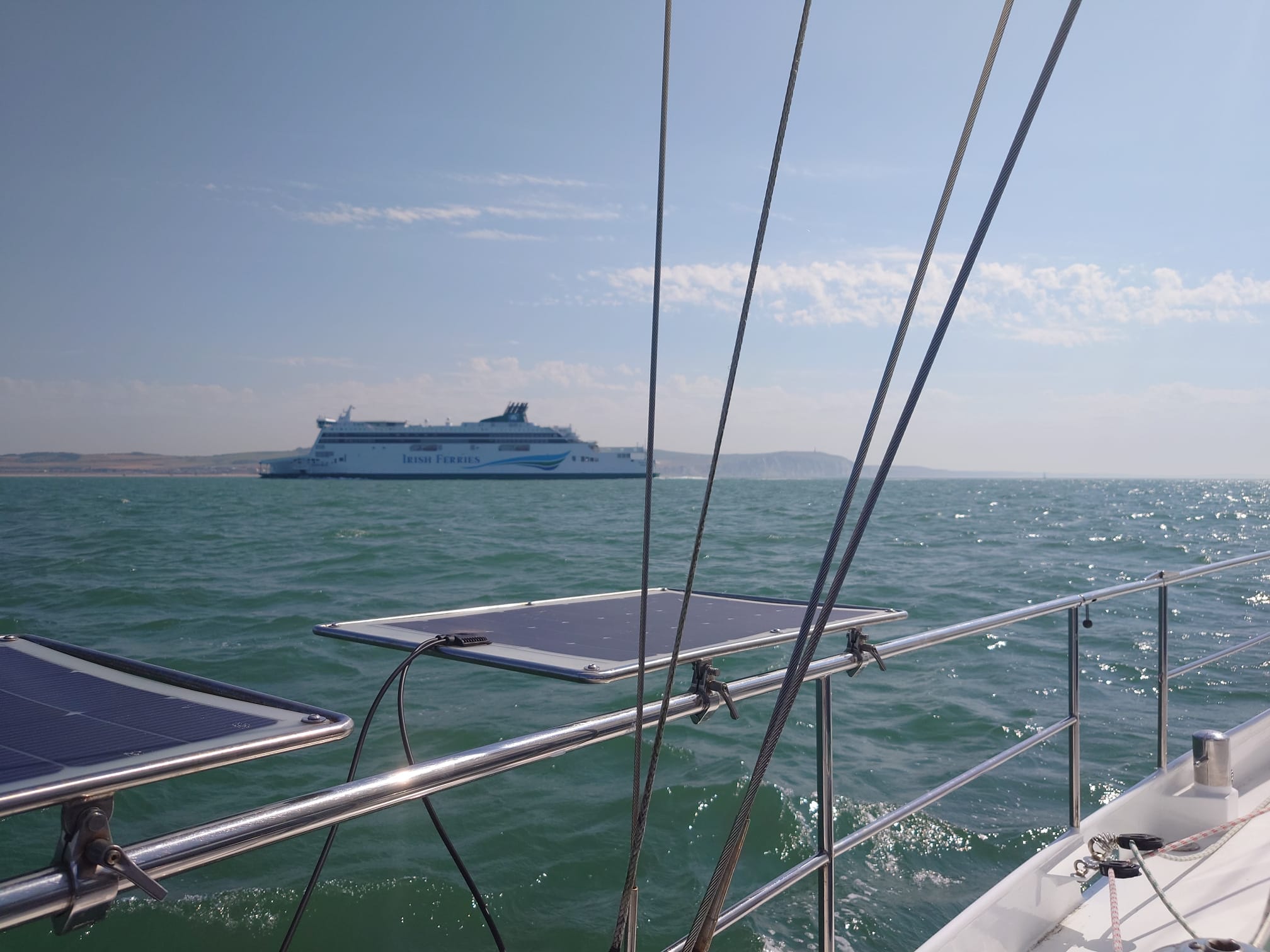
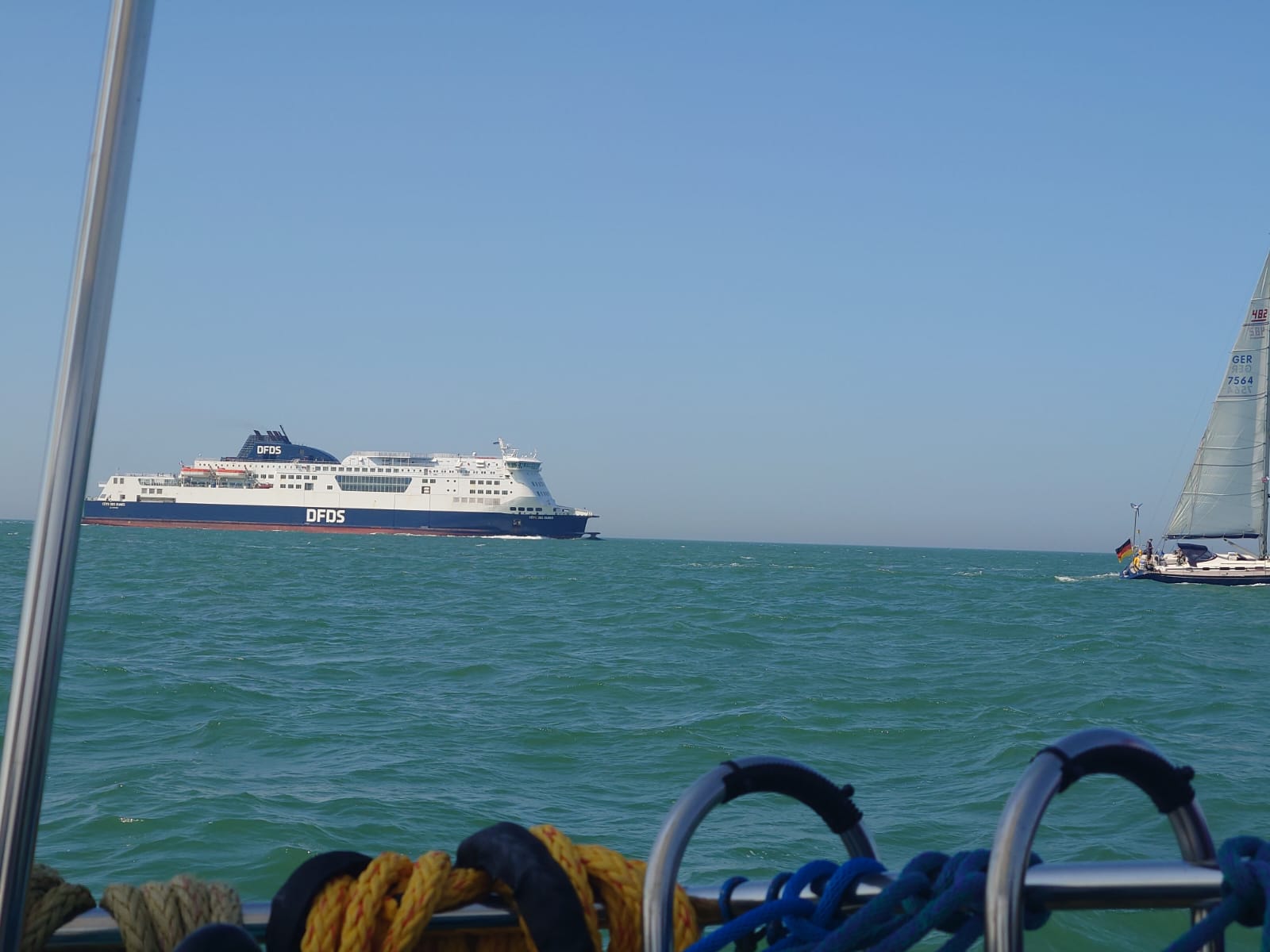

The light breeze is North-East, 5-10knots so we keep sailing nicely. Again, it’s a beautiful sunny day.
Here we pass the white cliffs of Calais. We can’t see the white cliffs of Dover on the other side of the channel because it’s a bit hazy.
July 30 – Continuing on towards Cherbourg
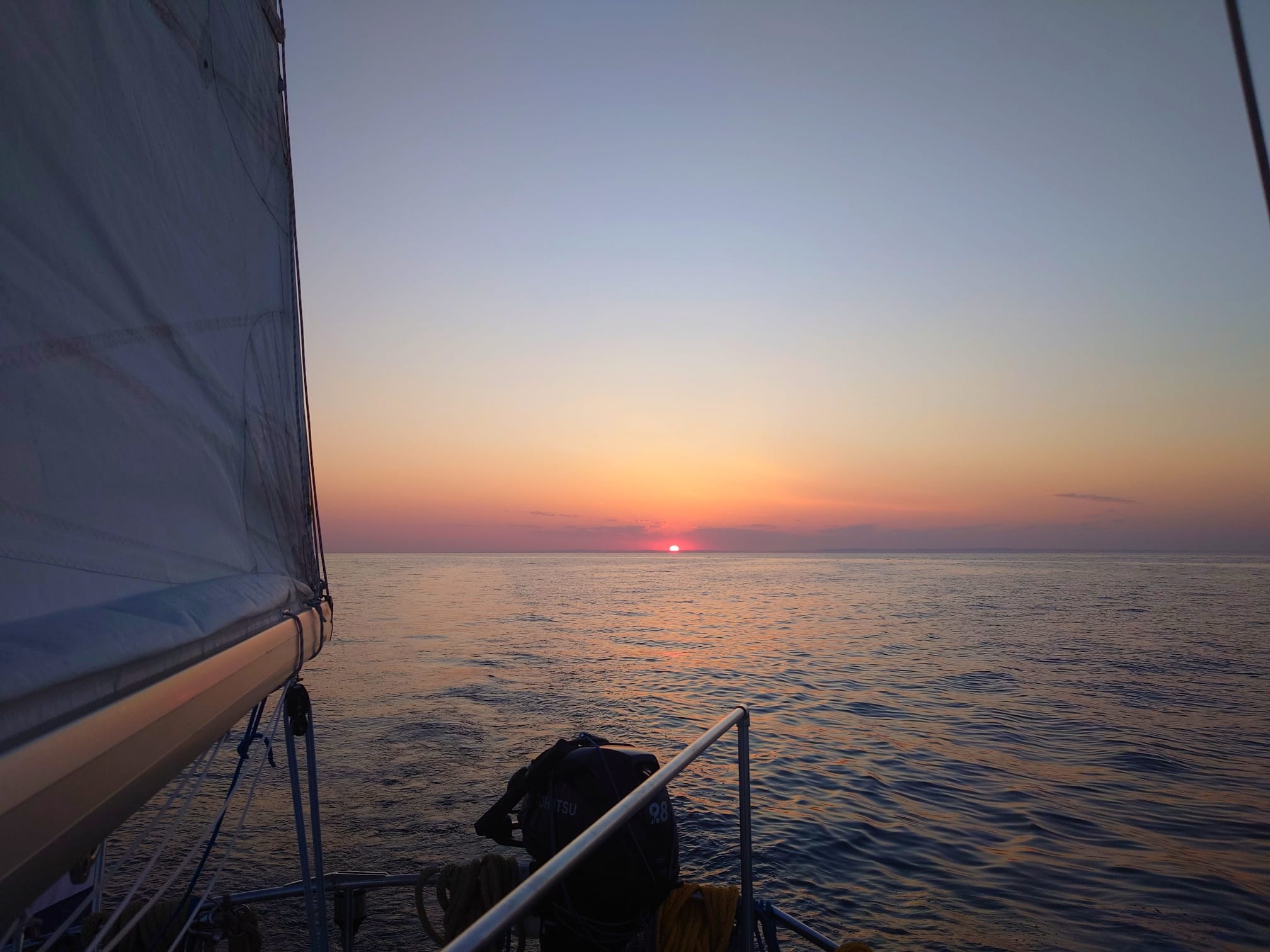
Sunrise at La Baie de Somme. Last night, the wind dropped down to a few knots, so we had to start the engine not to be pushed backwards by the current. We have almost 2 knots of current here that reverses every 6 hours. So, 6 hours we gain an extra 2 knots of speed and the next 6 hours we lose 2 knots of speed. So, if our sailing speed drops below the 2 knots we go backwards. We don’t mind going slow because we have plenty of time and a very nice weather forecast for the next days but sailing backwards is too frustrating. So, in that case we call for help from the “Mighty Mitsu” (aka engine) 🙂 (our engine).
In the late morning, the wind returns. About 10 knots, still from the North-East, which is right on our stern. Since we left the Netherlands, we sail on the mizzen and yankee sails. With the spinnaker pole keeping the yankee sail stretched out so it keeps its surface area. We don’t use the main sail on a downwind course. The main sail takes away the wind from the yankee sail, so it doesn’t perform well. We keep the main folded up on the boom to give the yankee full wind. The Yankee sail is bigger (39 sq meters) than the mainsail (31 sq meters) so the Yankee generates more propulsion.
Again, it’s a lovely summer’s day and we have about 100 sea miles to go to Cherbourg. In the evening, some clouds appear and there is a warning for thunderstorms. We are a bit anxious about that and hope the thunderstorms stay at the hot mainland (it is 30-40°C in France) and stay away from the relatively cool sea. The sun goes down in the clouds.
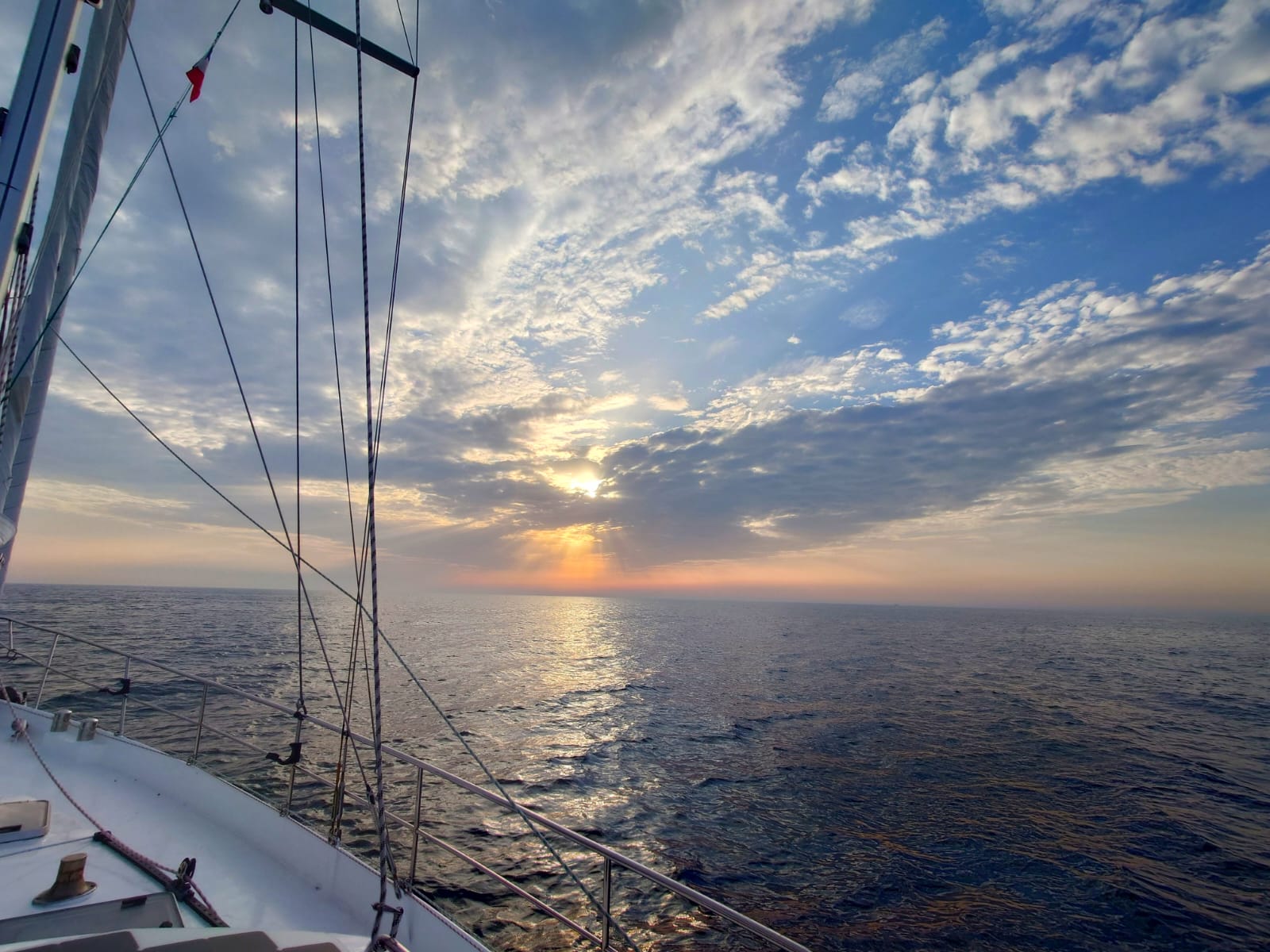

That night, we get a huge light show in the clouds behind us! We see hundreds of lightning flashes. Sometimes 5 at the same time! But luckily, the thunderstorms don’t reach us and indeed stay over the mainland . The wind drops down to almost nothing so we have to start the engine again when the current is against us.
Let us take you into our nightly experiences a bit:

During our 3-hour watch, we sit in the deck salon. Here, we sit comfy and we can look around through the large windows all around (front, side and back in our deck salon) while monitoring the equipment and listing to the VHF radio. Every 10 minutes we have a look outside because outside, in complete darkness, we have a better view on the lights around us. And of course, we can admire the beauty around us: the stars, the moon and sometimes bioluminescence – the sparkling bits like stars in the sea!

The most important source of information is the screen of the navigation computer. The most important boat data is displayed here: wind, speed, course, position, battery charge levels, rudder, engine, etc. And, most important, we see the charts with the ships around us (their AIS signals are displayed on the chart). The computer calculates how close a ship gets to us (CPA, Closest Point of Approach) and how long that will take (CPAT, Closest Point of Approach Time). If the CPA gets too small, we have to undertake action: change our course a bit to make an evasive maneuver or call the other vessel on the VHF radio to discuss what to do. Because some vessels might not have AIS, we can’t blindly rely on this screen. That’s why we look outside every 10 minutes. To check for lights that don’t correspond with the data on the screen. Some yachts don’t have AIS, which we find unbelievably stupid when sailing at open sea. It increases your safety hugely and it costs only a few hundred Euros nowadays. Some fishing vessels deliberately switch off their AIS when they’re fishing in prohibited areas (like the shipping lanes here) or when they have found large schools of fish and don’t want to attract the competitors. Crazy stupid! 🙁 Even though there’s a 5500 Euro fine for this behavior, they risk it. A full load of fish pays much more than that, after all… 🙁
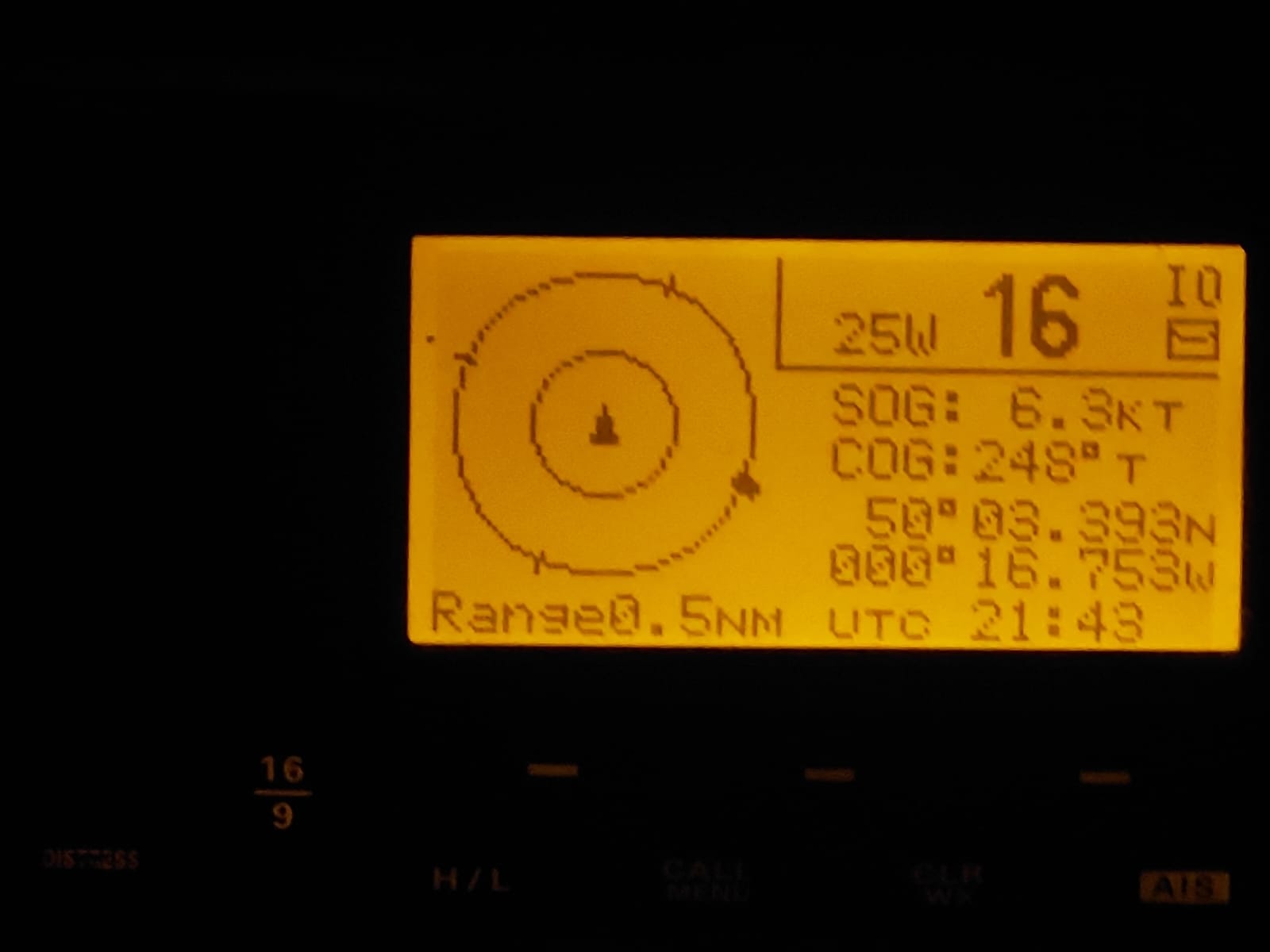
Another important piece of equipment is our VHF radio. This is the voice communication between ships within a 30-mile radius (line of sight). 24h a day, we hear the big vessels communicating with each other to discuss their course, the coastguard with all kinds of messages, the traffic control centers with all sorts of questions and remarks, and sometimes yachts communicating with each other.
The autopilot steers our boat at a compass course. Every now and then, we adjust the course by pushing buttons, so we don’t need to constantly steer by hand.
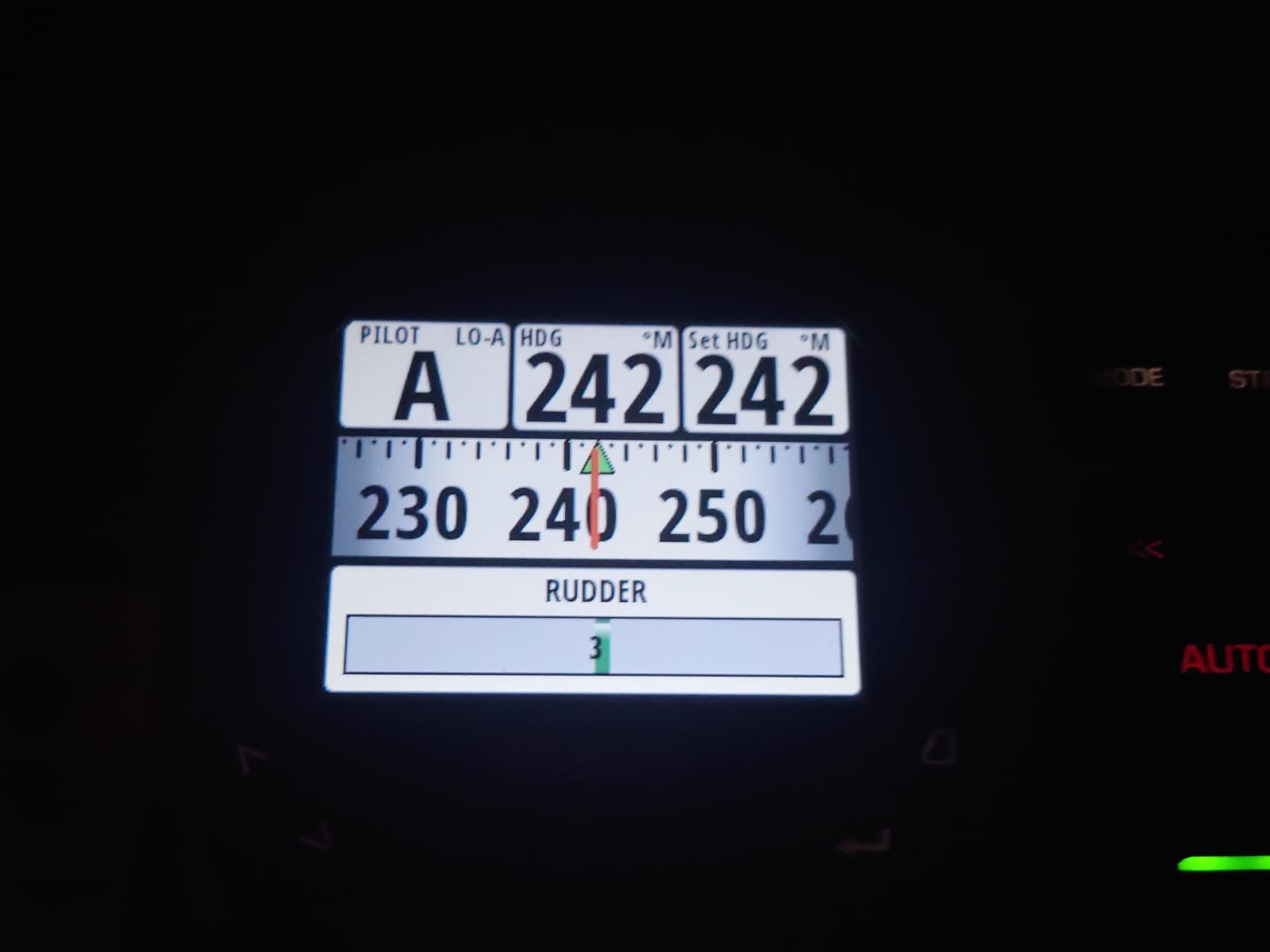
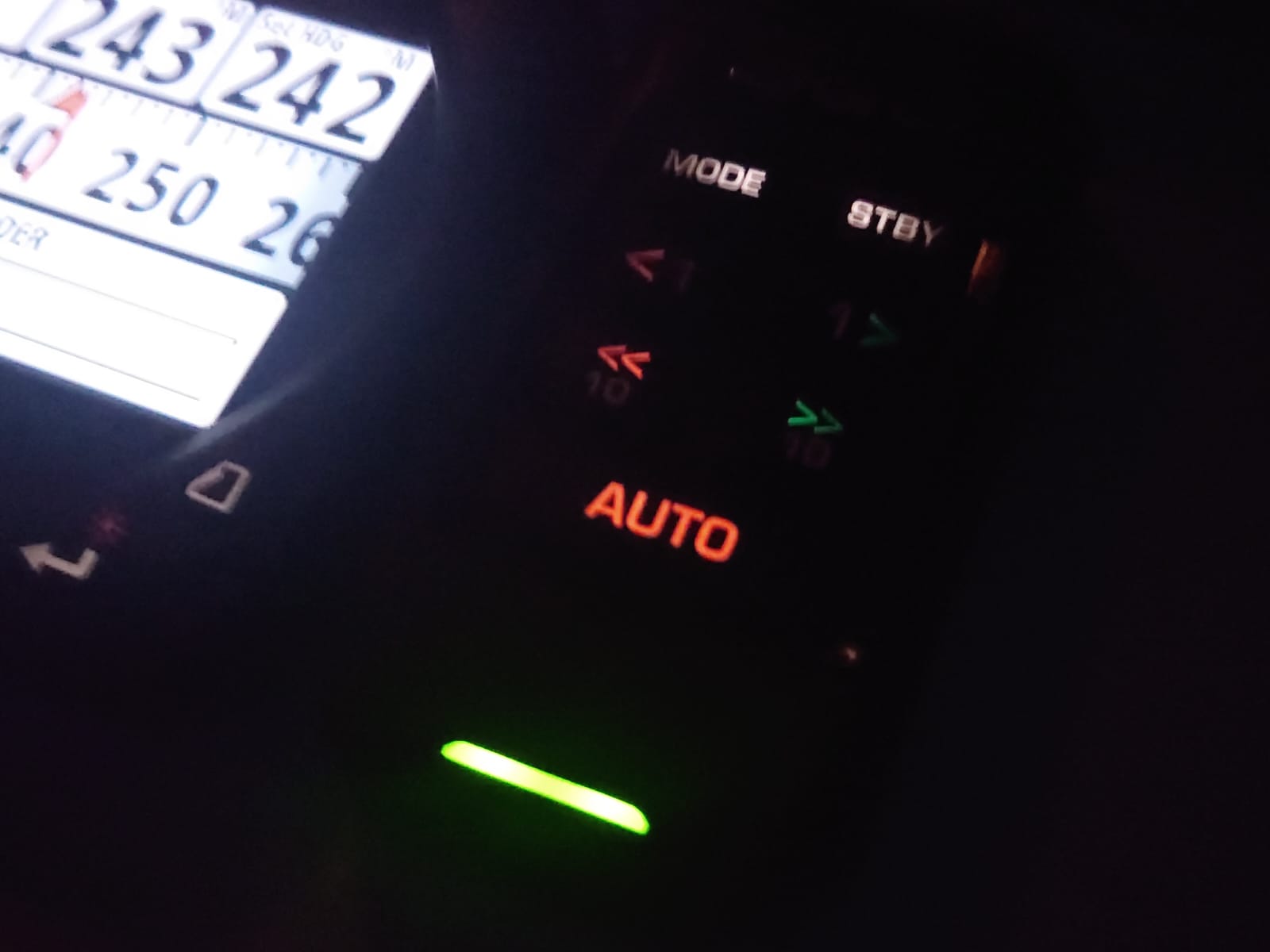
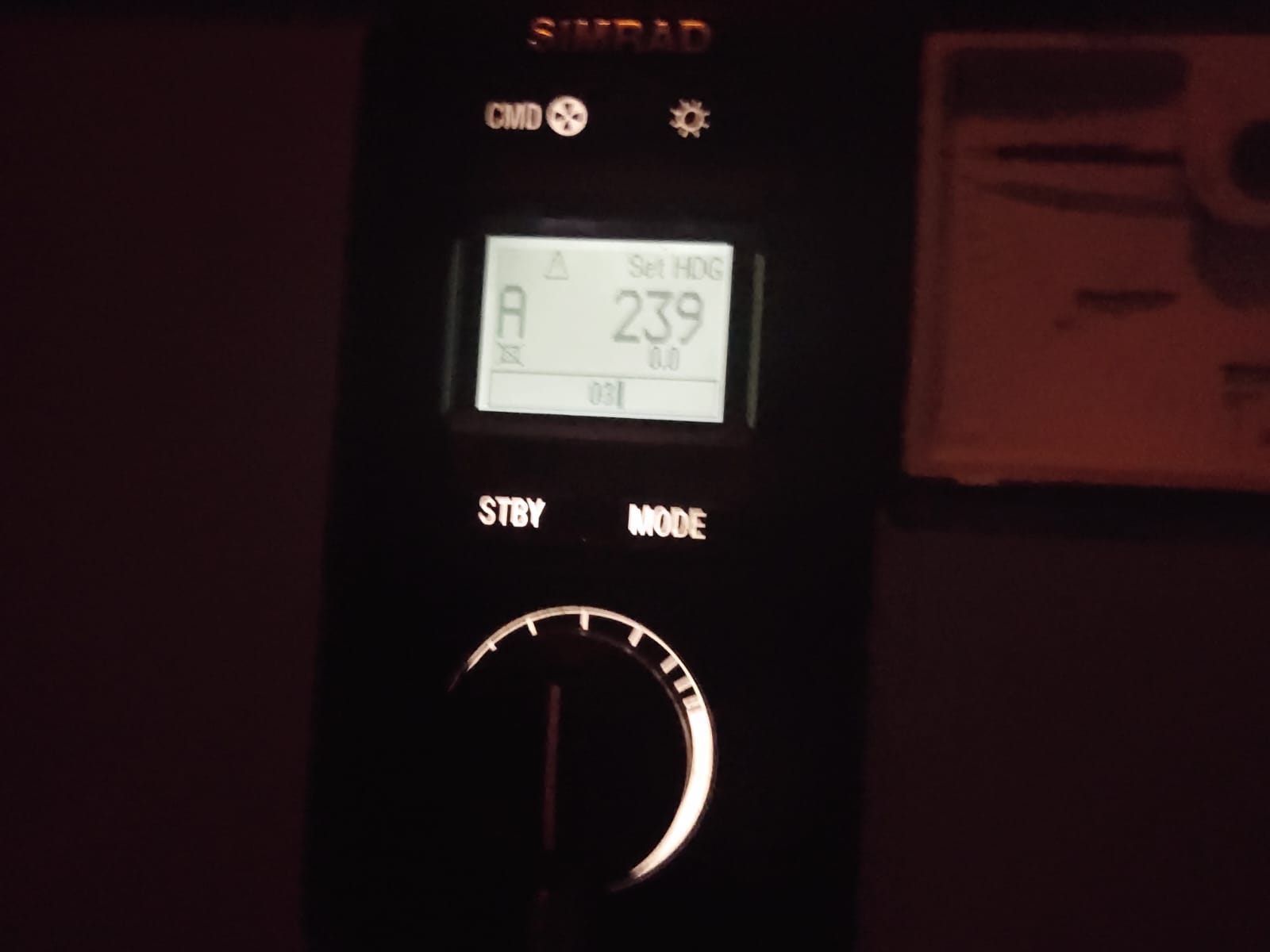

Also, we regularly check the weather forecasts on the internet. We download GRIB files that display the wind forecasts and we look at the French Meteorological site for the maritime forecasts.
Our new high-power marine 5G antenna and our new router perform great! Even at 40 nautical miles offshore we have a good internet connection! This image is from the router saying we have a fair signal and a stable internet connection in the middle of La Baie de Somme at our maximum distance from land (40nm), on this passage.
We do have some issues with the telecom operators though. Roaming is sometimes a problem: the Dutch SIM cards sometimes are not accepted by the French telecom operators. So, quite frequently the connection is interrupted and we have to switch to another SIM (there are 2 SIM cards in the router. KPN and T-Mobile, both Dutch operators) or wait until we get connected to another cell tower ashore. But in general, we have frequent whether updates, which is great!
In the near future, this issue will be solved when we buy a local in-country SIM card for data.
July 31 – Arriving in Cherbourg
Luckily, the thunderstorms stay far away from us and die out during the night. Just before daylight (at 4 o’clock), the wind picks up and we stop the engine and we set the sails again.
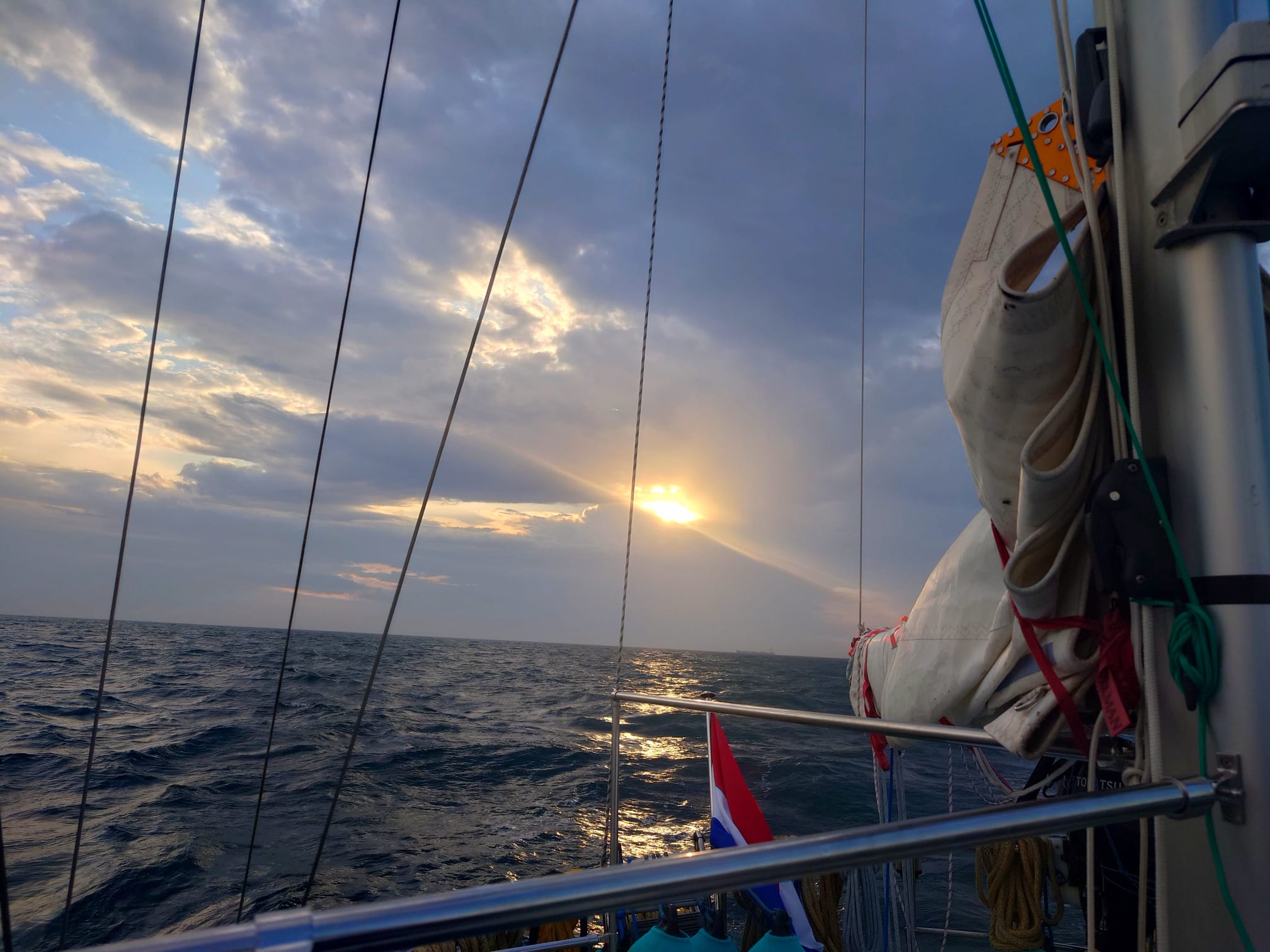
Sunrise. About 50 miles to go to Cherbourg. The wind increases to 20 knots from the North-East (right at our stern) and we have 3 knots of current against us. This results in a very choppy sea and Dione IV gets rocking and rolling, but she takes the sea in good measure. And despite of the current we make good speed thanks to the wind.
By the end of the morning, the current reverses and the wind eases down. The sea calms down and we gently glide into Cherbourg.

By 1 o’clock we tie up in the marina of Cherbourg.
280 nautical miles (about 500km) in 3 days and 3 nights. That’s not a fast passage but we weren’t in a hurry and it has been lovely calm weather all the time.
We did really well on our first passage together! We’re not too tired because we slept reasonably well with our 3-hour shifts. We have full confidence in each other’s sailing capabilities, so when one of us has the watch, the other can sleep peacefully. We had delicious meals, a thousand gorgeous views, we saw porpoises (but no dolphins) and gannets, and we just enjoyed being at sea! In fact, we feel a bit sorry that we are tied up in this extremely busy and noisy marina and we decide to get out of here after provisioning as soon as possible!… tomorrow 🙂
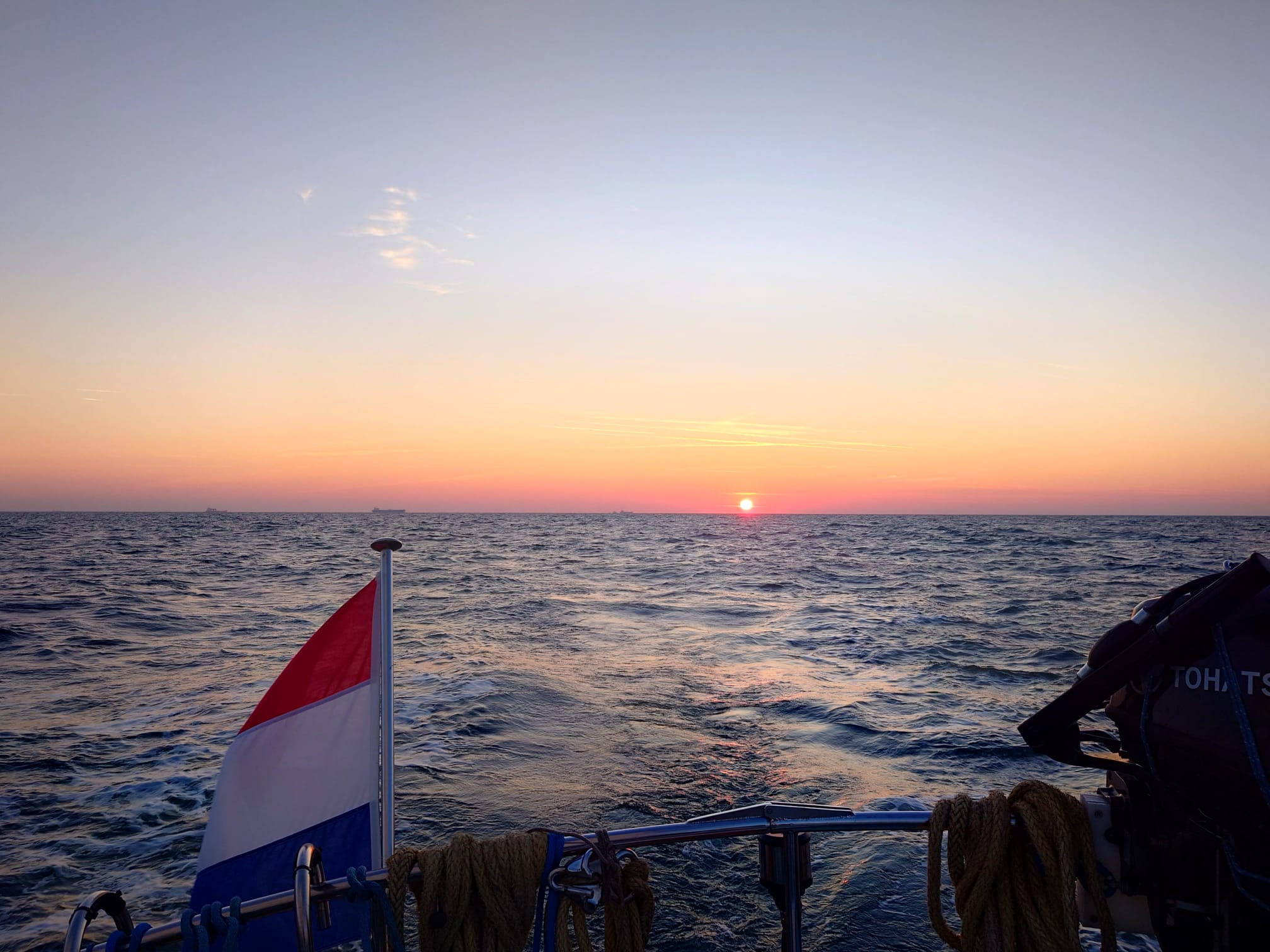
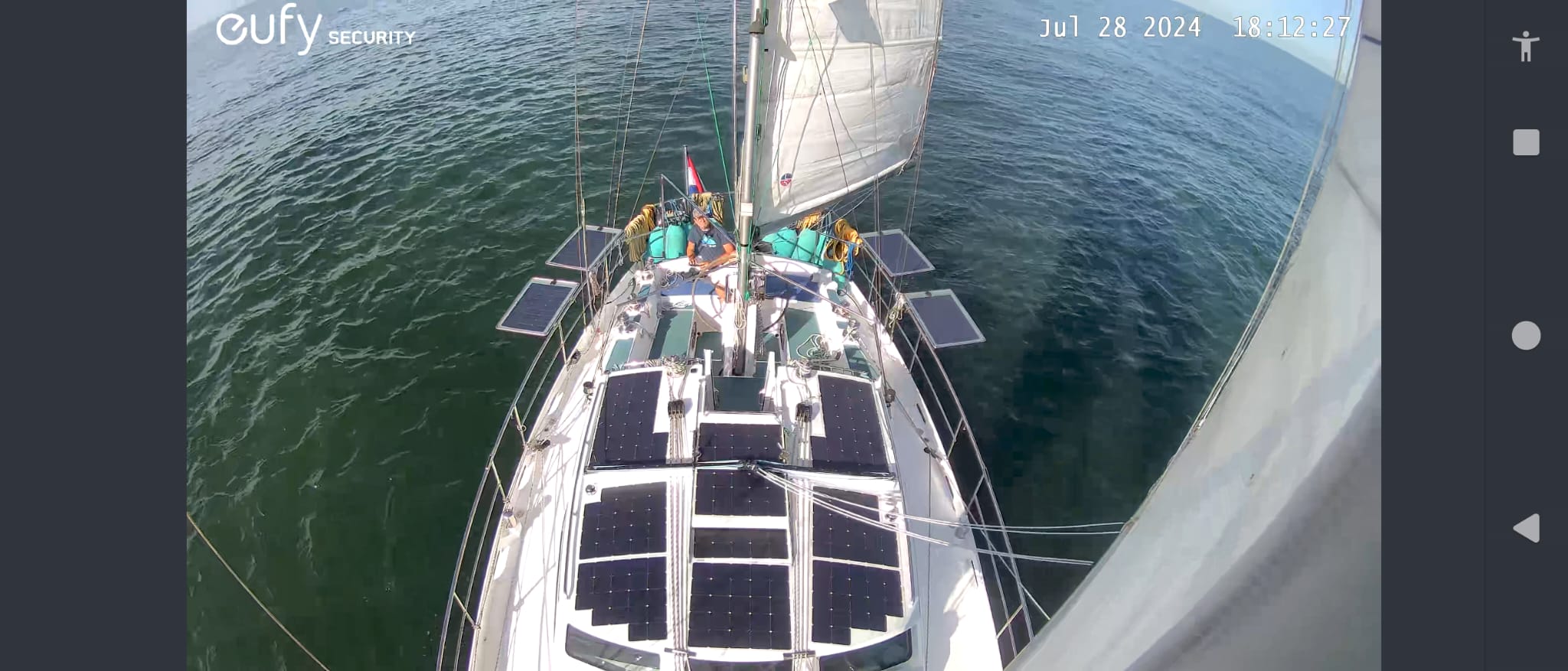
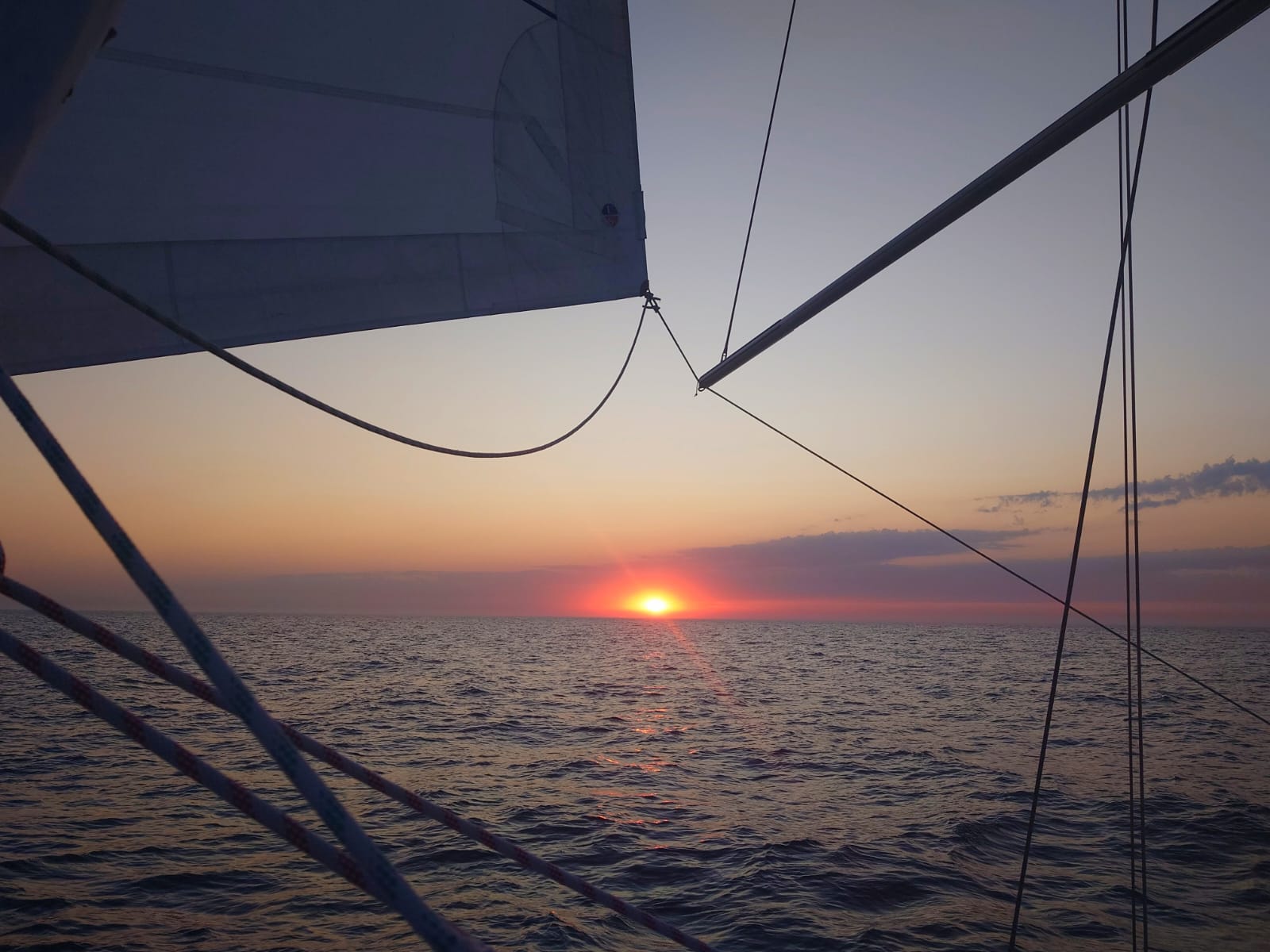

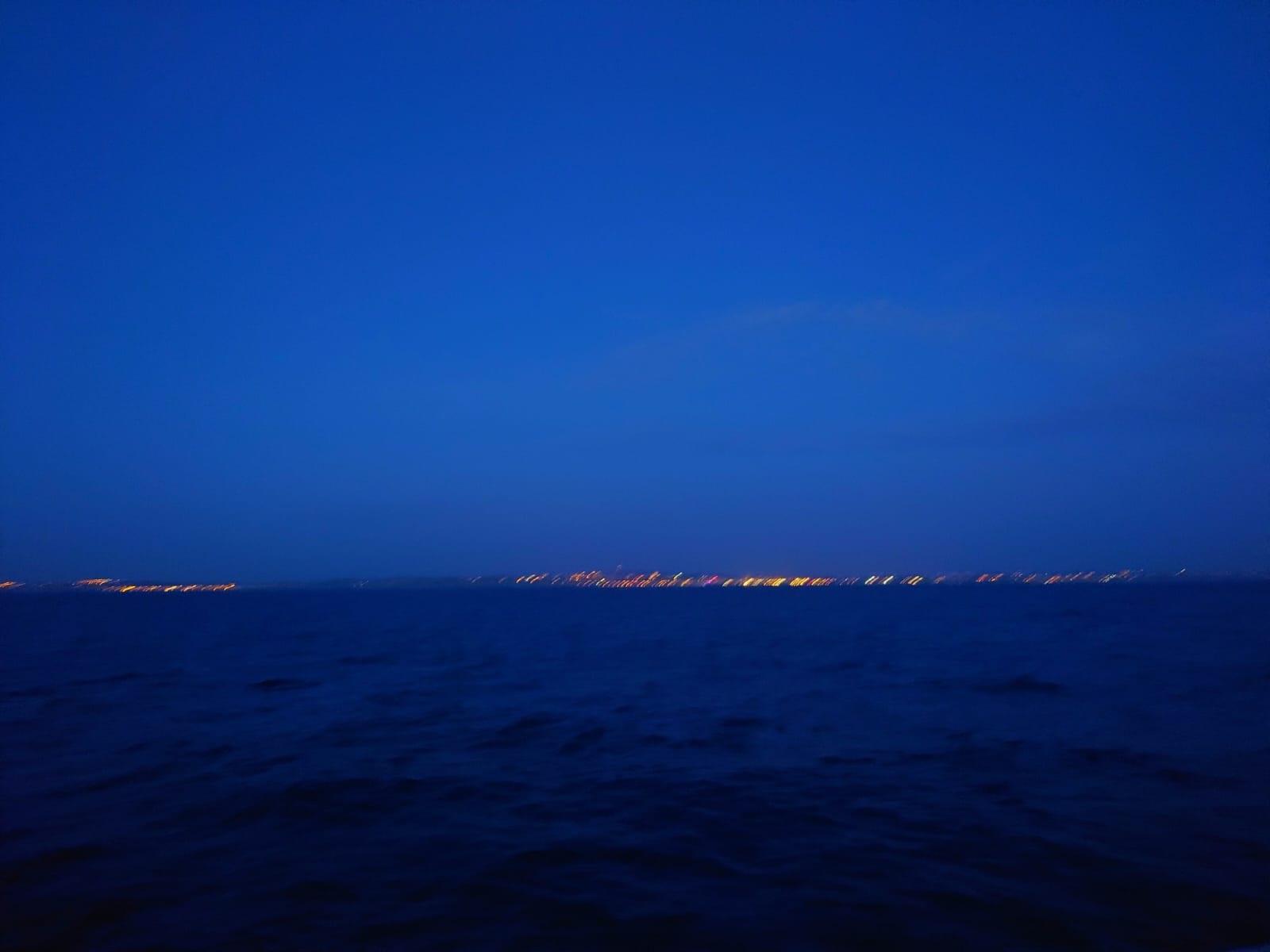
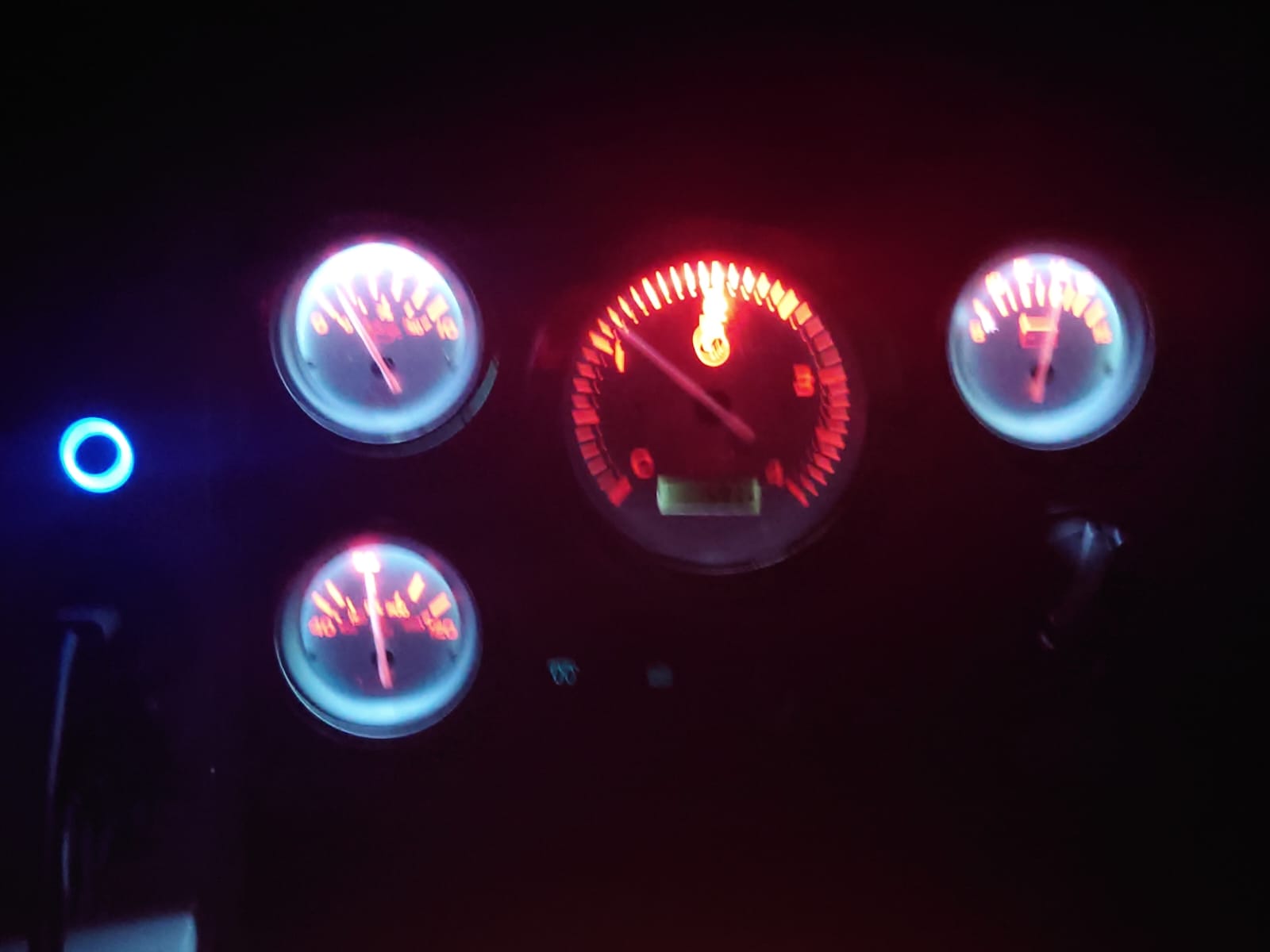
Leave a Reply